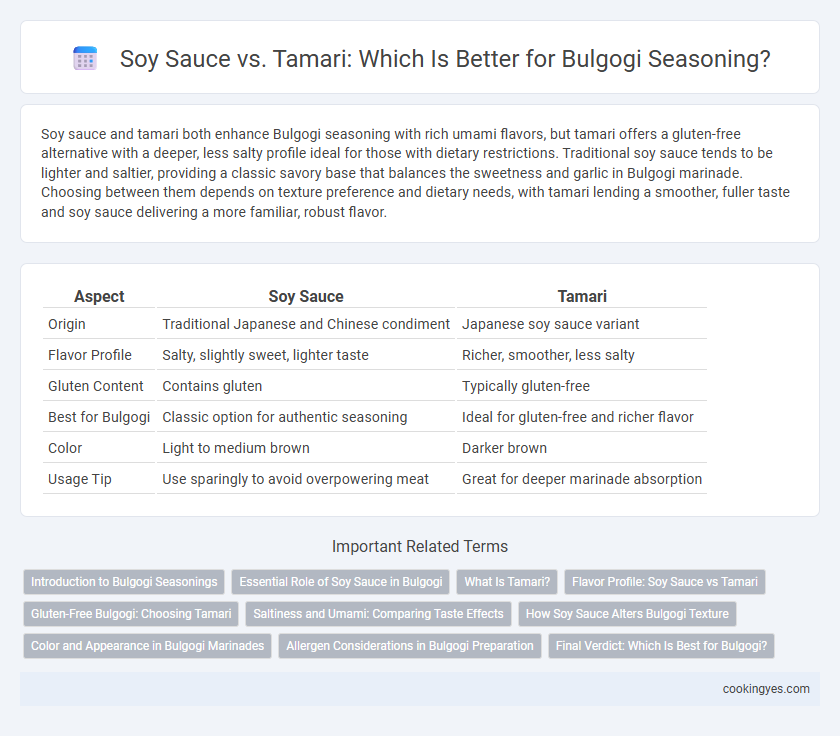Soy sauce and tamari both enhance Bulgogi seasoning with rich umami flavors, but tamari offers a gluten-free alternative with a deeper, less salty profile ideal for those with dietary restrictions. Traditional soy sauce tends to be lighter and saltier, providing a classic savory base that balances the sweetness and garlic in Bulgogi marinade. Choosing between them depends on texture preference and dietary needs, with tamari lending a smoother, fuller taste and soy sauce delivering a more familiar, robust flavor.
Table of Comparison
| Aspect | Soy Sauce | Tamari |
|---|---|---|
| Origin | Traditional Japanese and Chinese condiment | Japanese soy sauce variant |
| Flavor Profile | Salty, slightly sweet, lighter taste | Richer, smoother, less salty |
| Gluten Content | Contains gluten | Typically gluten-free |
| Best for Bulgogi | Classic option for authentic seasoning | Ideal for gluten-free and richer flavor |
| Color | Light to medium brown | Darker brown |
| Usage Tip | Use sparingly to avoid overpowering meat | Great for deeper marinade absorption |
Introduction to Bulgogi Seasonings
Soy sauce and tamari are essential soy-based seasonings used in Bulgogi preparation, each offering distinct flavor profiles and salt content that affect the dish's taste. Soy sauce, generally containing wheat, provides a balanced salty and umami flavor, while tamari is a gluten-free alternative with a richer, smoother taste and slightly less salt. Choosing between soy sauce and tamari influences the authenticity and dietary suitability of Bulgogi, making it crucial for achieving the desired seasoning intensity and flavor complexity.
Essential Role of Soy Sauce in Bulgogi
Soy sauce plays an essential role in Bulgogi seasoning by providing a balanced blend of salty, umami-rich flavors that enhance the marinated beef's tenderness and depth. Unlike tamari, which is thicker and less salty due to its gluten-free composition, soy sauce delivers the precise saltiness and subtle sweetness critical for the classic Korean barbecue taste. The fermentation process of traditional soy sauce develops complex amino acids that intensify Bulgogi's savory profile, making it indispensable in authentic recipes.
What Is Tamari?
Tamari is a type of Japanese soy sauce that is traditionally brewed with little to no wheat, making it a gluten-free alternative ideal for Bulgogi seasoning. Its rich, smooth flavor profile enhances the sweetness and umami of the marinated beef without overpowering the dish. Using tamari instead of regular soy sauce results in a deeper, less salty taste that complements the balance of garlic, sesame oil, and sugar in authentic Bulgogi recipes.
Flavor Profile: Soy Sauce vs Tamari
Soy sauce provides a balanced umami flavor with a slightly salty and sweet profile that enhances Bulgogi's savory richness. Tamari offers a deeper, less salty taste with robust umami notes, making it ideal for those seeking a gluten-free alternative without sacrificing complexity. The choice between soy sauce and tamari directly influences Bulgogi's flavor depth and overall seasoning balance.
Gluten-Free Bulgogi: Choosing Tamari
Tamari is a gluten-free soy sauce alternative derived primarily from fermented soybeans and contains little to no wheat, making it ideal for gluten-free Bulgogi seasoning. Its rich, savory flavor enhances the marinade without compromising taste or texture, ensuring authentic Korean BBQ essence. Tamari provides a balanced umami profile that complements the sweetness and spice in Bulgogi while accommodating dietary restrictions.
Saltiness and Umami: Comparing Taste Effects
Soy sauce and tamari both enhance Bulgogi's flavor with saltiness and umami but differ in intensity and depth. Soy sauce typically provides a sharper saltiness with a lighter, sweeter profile, while tamari offers a richer, smoother umami taste and less saltiness, making it ideal for balancing meat's natural flavors. Choosing tamari can result in a more complex, savory Bulgogi experience, especially for those seeking a gluten-free option with nuanced taste.
How Soy Sauce Alters Bulgogi Texture
Soy sauce enhances Bulgogi's texture by tenderizing the meat through its natural enzymes and moisture content, resulting in a juicier and more succulent bite. The fermentation process of soy sauce introduces amino acids that break down protein fibers, softening the beef while preserving its chewiness. Unlike Tamari, soy sauce's lighter consistency allows for better absorption into the meat, giving Bulgogi a balanced and tender texture.
Color and Appearance in Bulgogi Marinades
Soy sauce typically imparts a lighter, reddish-brown hue to Bulgogi marinades, creating a glossy, inviting appearance on cooked meat. Tamari, being richer and darker, results in a deeper, almost black-brown color, enhancing the visual intensity of the dish. The choice between soy sauce and tamari directly influences the final color and glossiness of Bulgogi, affecting its overall presentation.
Allergen Considerations in Bulgogi Preparation
Soy sauce and tamari differ significantly in allergen content, affecting Bulgogi seasoning choices; soy sauce typically contains wheat, which poses a challenge for gluten-sensitive individuals, while tamari is often gluten-free, making it a safer option for those with gluten intolerance. Selecting tamari ensures a rich, savory flavor without the allergenic risk associated with regular soy sauce, enhancing Bulgogi's taste profile while accommodating dietary restrictions. For allergen-conscious Bulgogi preparation, prioritizing tamari maintains traditional umami elements and supports inclusive dining experiences.
Final Verdict: Which Is Best for Bulgogi?
Soy sauce offers a balanced combination of saltiness and umami that enhances the sweet and savory profile of Bulgogi, making it the traditional choice for authentic flavor. Tamari, being gluten-free and having a deeper, less salty taste, suits those with dietary restrictions or preference for a milder soy flavor, but may alter the classic Bulgogi taste. For the best Bulgogi seasoning, regular soy sauce remains the optimal option, preserving the dish's signature flavor while adding complexity to the marinade.
Soy sauce vs Tamari for Bulgogi seasoning Infographic

 cookingyes.com
cookingyes.com